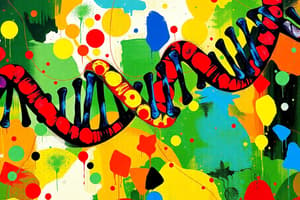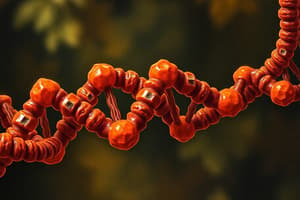Podcast
Questions and Answers
What is the process called where DNA is transcribed into mRNA?
What is the process called where DNA is transcribed into mRNA?
- Translocation
- Translation
- Transcription (correct)
- Replication
Which base pairs with adenine according to Chargaff's data?
Which base pairs with adenine according to Chargaff's data?
- Uracil
- Thymine (correct)
- Guanine
- Cytosine
What are the sides of the DNA ladder composed of?
What are the sides of the DNA ladder composed of?
- Nitrogenous bases
- Ribose and phosphate
- Sugar-phosphate molecules (correct)
- Amino acids
What does the term semiconservative refer to in molecular biology?
What does the term semiconservative refer to in molecular biology?
How do tRNAs recognize the correct codons in mRNA?
How do tRNAs recognize the correct codons in mRNA?
Which enzyme is responsible for unwinding DNA during replication?
Which enzyme is responsible for unwinding DNA during replication?
What type of molecule is mRNA after transcription?
What type of molecule is mRNA after transcription?
Which of the following is NOT involved in the central dogma of molecular biology?
Which of the following is NOT involved in the central dogma of molecular biology?
What percentage of DNA is composed of thymine nucleotides if it contains 18% adenine nucleotides?
What percentage of DNA is composed of thymine nucleotides if it contains 18% adenine nucleotides?
In DNA replication, what is the primary role of helicase?
In DNA replication, what is the primary role of helicase?
What is the result of a malfunction in RNA polymerase?
What is the result of a malfunction in RNA polymerase?
Which chemical bond must be disrupted for DNA strands to separate during transcription?
Which chemical bond must be disrupted for DNA strands to separate during transcription?
According to Chargaff's rules, if DNA is made up of 28% adenine, what percentage of guanine is present?
According to Chargaff's rules, if DNA is made up of 28% adenine, what percentage of guanine is present?
Which of these statements about the central dogma of molecular biology is correct?
Which of these statements about the central dogma of molecular biology is correct?
What is the primary purpose of tRNA in protein synthesis?
What is the primary purpose of tRNA in protein synthesis?
During what process is mRNA synthesized?
During what process is mRNA synthesized?
What is the function of DNA ligase during DNA replication?
What is the function of DNA ligase during DNA replication?
Which of the following processes occurs in the cytoplasm?
Which of the following processes occurs in the cytoplasm?
How does the mRNA sequence relate to the DNA template strand?
How does the mRNA sequence relate to the DNA template strand?
What type of nucleic acid is produced during the process of transcription?
What type of nucleic acid is produced during the process of transcription?
What is a key difference between RNA and DNA?
What is a key difference between RNA and DNA?
Flashcards
Central Dogma
Central Dogma
The flow of genetic information from DNA to RNA to protein.
Transcription
Transcription
The process of copying genetic information from DNA to RNA. This occurs in the nucleus.
Chargaff's Rule
Chargaff's Rule
Adenine (A) always pairs with Thymine (T), and Guanine (G) pairs with Cytosine (C) in DNA.
DNA Structure
DNA Structure
Signup and view all the flashcards
Semiconservative Replication
Semiconservative Replication
Signup and view all the flashcards
tRNA recognition
tRNA recognition
Signup and view all the flashcards
Unwinding enzyme in DNA replication
Unwinding enzyme in DNA replication
Signup and view all the flashcards
DNA Replication Steps
DNA Replication Steps
Signup and view all the flashcards
What adds nucleotides in DNA replication?
What adds nucleotides in DNA replication?
Signup and view all the flashcards
What's the difference between DNA and RNA?
What's the difference between DNA and RNA?
Signup and view all the flashcards
What does RNA polymerase do?
What does RNA polymerase do?
Signup and view all the flashcards
What is transcription?
What is transcription?
Signup and view all the flashcards
What is translation?
What is translation?
Signup and view all the flashcards
What is tRNA?
What is tRNA?
Signup and view all the flashcards
What is rRNA?
What is rRNA?
Signup and view all the flashcards
Where does translation occur?
Where does translation occur?
Signup and view all the flashcards
What is the central dogma of molecular biology?
What is the central dogma of molecular biology?
Signup and view all the flashcards
What must happen before transcription or replication?
What must happen before transcription or replication?
Signup and view all the flashcards
Study Notes
DNA Replication and Transcription
- Central Dogma: Genetic information flows from DNA to RNA to protein.
- Transcription: DNA is transcribed into mRNA in the nucleus.
- RNA Types: mRNA carries the genetic code from DNA to ribosomes; rRNA forms part of ribosomes; tRNA carries amino acids. DNA -> mRNA-> Protein
- DNA Structure: A twisted ladder; rungs made of nitrogenous bases (A-T, G-C); sides composed of sugar-phosphate molecules.
- Semiconservative Replication: Each new DNA molecule consists of one old strand and one new strand.
Chargaff's Rules
- Base Pairing: Adenine (A) pairs with Thymine (T), and Guanine (G) pairs with Cytosine (C).
DNA Replication
- Unwinding: Helicase unwinds the DNA double helix.
- Enzymes: DNA polymerase adds complementary nucleotides; DNA ligase joins DNA fragments.
Translation
- tRNA and Codons: tRNA anticodons bind to mRNA codons (complementary base pairing) bringing the correct amino acid.
RNA vs. DNA
- Structure: RNA is single-stranded; DNA is double-stranded.
- Bases: RNA contains uracil (U) instead of thymine (T).
Processes and Locations
- Transcription: Occurs in the nucleus.
- Translation: Occurs in the cytoplasm.
- DNA Replication: Occurs in the nucleus.
- Intron removal: Occurs in the nucleus (part of mRNA processing)
Process Details
- DNA Replication: Semiconservative process; each new DNA molecule has one old and one new strand.
- Base Pair Ratios: If DNA has 18% adenine, it also has 18% thymine; that leaves 64% left over divided by 2 to get 32% guanine and 32% cytosine.
- mRNA Formation: RNA polymerase creates mRNA from DNA template (complementary bases).
Enzyme Roles
- Helicase: Separates DNA strands during replication.
- RNA Polymerase: Creates mRNA during transcription.
- DNA Polymerase: Adds nucleotides during replication.
- DNA Ligase: Joins DNA fragments.
mRNA vs Other Types
- mRNA: Carries genetic code for protein synthesis.
- rRNA: Forms part of the ribosomes that read the mRNA.
- tRNA: Carries amino acids to the ribosome.
Studying That Suits You
Use AI to generate personalized quizzes and flashcards to suit your learning preferences.
Description
Test your knowledge on the central dogma of molecular biology, focusing on DNA replication and transcription processes. This quiz covers key concepts such as the structure of DNA, the function of different types of RNA, and the roles of essential enzymes in replication and translation.




